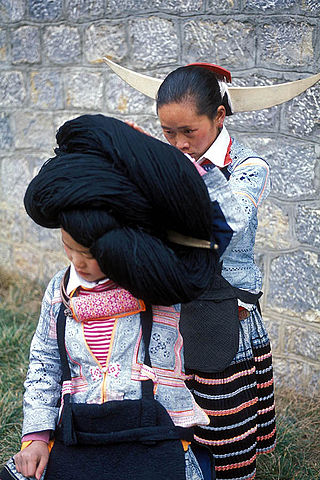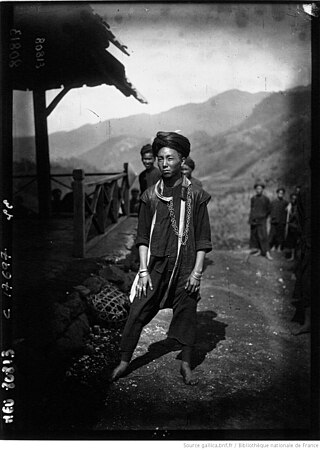
Laos, officially the Lao People's Democratic Republic, is the only landlocked country in Southeast Asia. At the heart of the Indochinese Peninsula, Laos is bordered by Myanmar and China to the northwest, Vietnam to the east, Cambodia to the southeast, and Thailand to the west and southwest. Its capital and largest city is Vientiane.

The Hmong people are an indigenous group in East and Southeast Asia. In China, the Hmong people are classified as a sub-group of the Miao people. The modern Hmong reside mainly in Southwest China and countries in Southeast Asia such as Vietnam, Laos, Thailand, and Myanmar. There is also a large diasporic community in the United States of more than 300,000. The Hmong diaspora has smaller communities in Australia and South America.

Chiyou is a mythological being that appears in Chinese mythology. He was a tribal leader of the Nine Li tribe in ancient China. He is best known as a king who lost against the future Yellow Emperor during the Three Sovereigns and Five Emperors era in Chinese mythology. According to the Song dynasty history book Lushi, Chiyou's surname was Jiang (姜), and he was a descendant of the Flame Emperor.

The Miao are a group of linguistically related peoples living in Southern China and Southeast Asia, who are recognized by the government of China as one of the 56 official ethnic groups. The Miao live primarily in the mountains of southern China. Their homeland encompasses the provinces of Guizhou, Yunnan, Sichuan, Hubei, Hunan, Guangxi, Guangdong, and Hainan. Some sub-groups of the Miao, most notably the Hmong people, have migrated out of China into Southeast Asia. Following the communist takeover of Laos in 1975, a large group of Hmong refugees resettled in several Western nations, mainly in the United States, France, and Australia.

The Hmong–Mien languages are a highly tonal language family of southern China and northern Southeast Asia. They are spoken in mountainous areas of southern China, including Guizhou, Hunan, Yunnan, Sichuan, Guangxi, and Hubei provinces; the speakers of these languages are predominantly "hill people", in contrast to the neighboring Han Chinese, who have settled the more fertile river valleys.

Hmong or Mong is a dialect continuum of the West Hmongic branch of the Hmongic languages spoken by the Hmong people of Sichuan, Yunnan, Guizhou, Guangxi, Hainan, northern Vietnam, Thailand, and Laos. There are some 2.7 million speakers of varieties that are largely mutually intelligible, including over 280,000 Hmong Americans as of 2013. Over half of all Hmong speakers speak the various dialects in China, where the Dananshan (大南山) dialect forms the basis of the standard language. However, Hmong Daw and Mong Leng are widely known only in Laos and the United States; Dananshan is more widely known in the native region of Hmong.
The insurgency in Laos is a low-intensity conflict between the Laotian government on one side and former members of the Secret Army, Laotian royalists, and rebels from the Hmong and lowland Lao ethnic minorities on the other. These groups have faced reprisals from the Lao People's Army and Vietnam People's Army for their support of the United States-led, anti-communist military campaigns in Laos during the Laotian Civil War, which the insurgency is an extension of itself. The North Vietnamese invaded Laos in 1958 and supported the communist Pathet Lao. The Vietnamese communists continued to support the Pathet Lao after the end of the Laotian Civil War and the establishment of the Lao People's Democratic Republic.

Pa Chay Vue,, commonly referred to as Pa Chay or Batchai, led the Hmong people in the War of the Insane revolt against French rule in French Indochina from 1918 to 1921. He was considered a hero among the Hmong nationalists, but regarded as a crazed man among the French-subdued Hmong, but in present times, he is unanimously considered a national hero.
Vue Pa Chay's revolt, also called War of the Insane or the Madman's War by French sources, was a Hmong revolt against taxation in the French colonial administration in Indochina lasting from 1918 to 1921. Vue Pa Chay, the leader of the revolt, regularly climbed trees to receive military orders from heaven. The French granted the Hmong a special status in 1920, effectively ending the conflict.

Pahawh Hmong is an indigenous semi-syllabic script, invented in 1959 by Shong Lue Yang, to write two Hmong languages, Hmong Daw (Hmoob Dawb White Miao) and Hmong Njua AKA Hmong Leng (Moob Leeg Green Miao).

The Miao rebellions in the Ming dynasty were a series of rebellions of the indigenous tribes of southern China against the Ming dynasty, from the 14th to the 15th centuries. The Ming defeated the rebels with overwhelming force. Later, during the Qing dynasty, another series of Miao rebellions broke out.

The Hmongic languages, also known as Miao languages, include the various languages spoken by the Miao people. Hmongic languages also include various languages spoken by non-Mienic-speaking Yao people, such as Pa-Hng, Bunu, Jiongnai, Younuo, and others, while She is spoken by ethnic She people.
There have been several rebellions among the Miao people in Chinese history:
The Miao rebellion of 1854–1873, also known as the Qian rebellion was an uprising of ethnic Miao and other groups in Guizhou province during the reign of the Qing dynasty. Despite its name, Robert Jenks estimates that ethnic Miao made up less than half of the uprising's participants. The uprising was preceded by Miao rebellions in 1735–36 and 1795–1806, and was one of many ethnic uprisings sweeping China in the 19th century. The rebellion spanned the Xianfeng and Tongzhi periods of the Qing dynasty, and was eventually suppressed with military force. Estimates place the number of casualties as high as 4.9 million out of a total population of 7 million, though these figures are likely overstated.

Kev Dab Kev Qhuas is the common ethnic religion of the Miao people, best translated as the "practice of spirituality". The religion is also called Hmongism by a Hmong American church established in 2012 to organize it among Hmong people in the United States.

Hmong: History of a People is a book by H. Keith Quincy, PhD, published by the Eastern Washington University Press. It was initially published in 1988 with a revised edition published in 1995.
Hmong writing refers to the various writing systems that have been used for transcribing various Hmongic languages, spoken by Hmong people in China, Vietnam, Laos, the United States, and Thailand, these being the top five countries. Over a dozen scripts have been reported for Hmong, none of which is considered standard for transcribing the languages in the eyes of the speakers.

Ban Phou Pheung Noi is a Laotian village located at the peak of Phou Pheung mountain in the Xieng Khouang province of Laos. Phou Pheung mountain is approximately 916 m (3,005 ft). During the Vietnam War, combat between the American allies, the Hmong, and the Pathet Lao, The Laos Marxist government, and the Communist North Vietnamese People's Army took place on the mountain. Phou Pheung mountain runs from east to west and is rocky, and is covered in tropical forests. It is south of Muang Soui - Nongtang-Nato, and west of Phou Douk, Muang Phuan, Phonsavan and Plain of Jars. To the east, about 10 miles from Ban Phou Pheung Noi, is the Num Ngum 4 hydroelectric dam.










